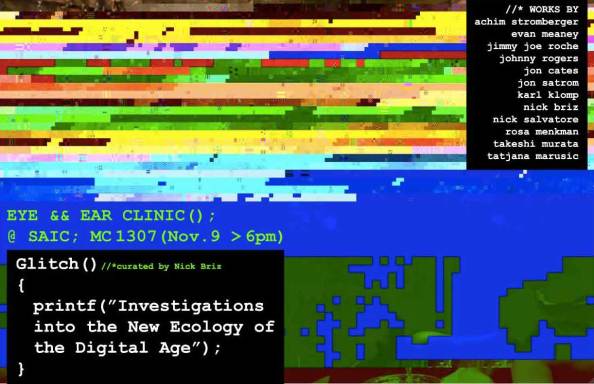Eye & Ear Clinic – School of the Art Institute of Chicago – 11.9.09 [on Facebook]
Glitch: Investigations into the New Ecology of the Digital Age curated by Nick Briz
“The genre [of glitch] has no recognizable center. No handle. It keeps moving, shape shifting. It blurs when it’s recognized and then only sharpens for brief periods. It is not a genre so much as a tactic for subversion that has become a fashion statement.” 1
– Kim Cascone
Glitch art is aestheticized and fetishized technological [human] errors or anticipated accidents that can produce unintended [desired] results. Glitch is digital entropy; it’s data-moshed-compression-artifacting-dirty-new-media-digi-noise. Glitching, ,as a process, is inherently reliant upon technology yet surprisingly accessible and executable. Glitch lends itself to pedagogy as much as it serves as a ruse to traditional modes of artistic instruction that codify random acts of creativity. Glitch art, both formally and conceptually, is resistant, foregrounding a critical relationship to the digital culture in ‘which we find ourselves mired. Glitch: Investigations into the New Ecology of the Digital Age initiates a conversation between glitch artists from all over the world with common concerns. These artists demonstrate the diversity of ways in which glitch can be used to critically address pertinent issues within digital culture, and in culture at large.
“From a media history standpoint it is also interesting to anthologize aspects of media, such as glitches, for they may be forgotten when our signals become more perfect and our glitches less visual” 2
– Iman Moradi
Though glitch as a visual (still) medium has been around for the better part of a decade and glitch music for some time before that, the focus of this program is the more contemporary pheno-menon of glitch as m-ov-ing image, in particular single channel video work.
Glitch art can function as a microcosm for new media art, foregrounding critical relationships to digital culture and/or culture in general. This potential is realized and explored by the artists in this program.
These artists take otherwise irritable and undesirable erroneous occurrences/malfunctions and embrace them as form. In their practice, as well as in many of their writings and research, errors and/or bugs are reshaped sometimes into elegant painterly digitalism, other times into a poetic and essayistic discourse, and often into spastic abrasive assaults of visual/audible noise. These works critically address issues of identity, memory, time, entropy, and chance in ways that may reflect on society’s dependency on technology questioning our understandings and relation to over-saturated-information-upgrade-culture. They attack the technological conventions that have been assumed, and the media systems that have been assimilated, by popular culture and subvert the slick, sterile, and seemingly perfect surface of technologies propagated by special interests.
Glitch art is not exclusively technical: the most basic methods utilized by glitch artists can be easily taught, learnt and executed. Methods such as datamoshing3 and wordpad glitching4 have opened a potentially democratic space for conceptually and aesthetically exploring our amorphous identities in our new digital ecology.
As technology exponentially evolves and naturally occurring ‘glitches’ are being phased out, the natural aesthetics of digital technology are at risk of obsolescence. A mutual threat is currently being posed between the new technologies/upgrades which seek to nullify glitches and the glitches which attempt to expose these technologieS/imposed systems. This program is an attempt to address this threat and generate dialogue about the critical importance and potential of glitch.
_________________________________
1 Moradi, Iman, et al. Glitch: Designing Imperfection. New York: Mark Batty Publisher, 2009. p19
2 Ibid, p9
3 http://www.youtube.com/watch ?v=tYytVzbPky8
4 http://www.animalswithinanimals.com/stallio/2008/08/databending-and-glitch-art-primer-part.html
Program:
1.Universal Process Leader.2009
Achim Stromberger.0:17
http://achimstromberger.wordpress.com/
2.The Memory of a Landscape.2004
Tatjana Marusic.12:00
http://tatjanamarusic.com/
3.Accidents in Celluloid and Pixels.2009
Rosa Menkman.2:33
http://rosa-menkman.blogspot.com/
4.NES Glitch
Compilation(excerpts).2001-2004
Johnny Rogers.6:00
http://www.geojedi.org/
5.green.qt_slippage.mov.1999
jonCates.0:02
http://systemsapproach.net/
6.Basement Bleeds.2009
Jimmy Joe Roche.1:16
http://www.jimmyjoeroche.com/
7.Power Wagons.2009
Jimmy Joe Roche.9:38
http://www.jimmyjoeroche.com/
8.Polygon Sun.2005
Johnny Rogers.3:38
http://www.geojedi.org/
9.Eagpostmucng.2009
Jon Satrom.0:25
http://jonsatrom.com/
10.Binary Quotes.2008
Nick Briz.5:32
http://nickbriz.com/
11.Rex.2005
Karl Klomp.3:32
http://karlklomp.nl/
12.Bellow.2009
Nick Salvatore.2:25
http://www.vimeo.com/user1222245
13.KANYE WEST “Welcome To Heartbreak” Directed by Satrom.2009
Jon Satrom.2:10
http://jonsatrom.com/
14.Tekfet.2009
Karl Klomp.6:37
http://karlklomp.nl/
15.Shannon’s Entropy.2008
Evan Meaney.6:03
http://www.evanmeaney.com/
16.Together In My Freezer/Washmountain.2.2009
Rosa Menkman.2:38
http://rosa-menkman.blogspot.com/
11.Sigrna-Fugue.2009
Evan Meaney.11:53
http://www.evanmeaney.com/
18.Untitled(Pink Dot).2006
Takeshi Murata.5:29
http://www.takeshimurata.com/
